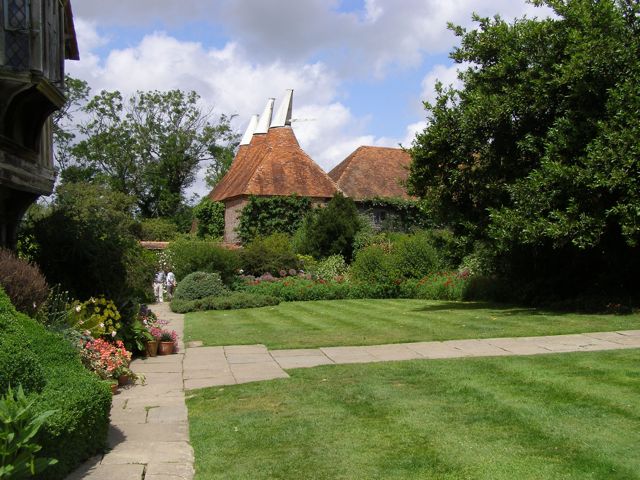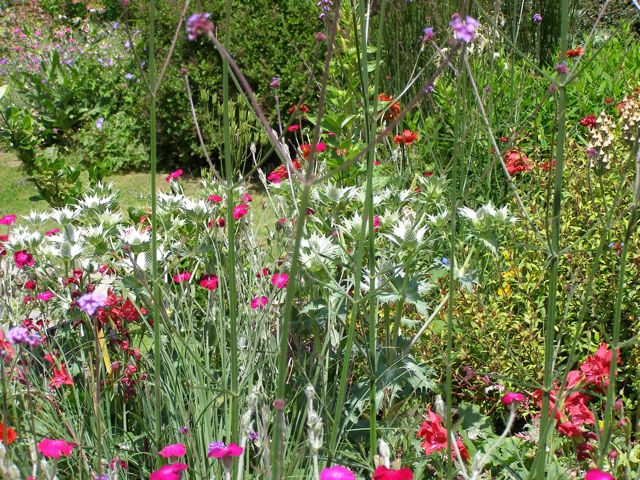
The trouble with this garden is that you might never make it further than the car park. Swinging in from the flatlands of East Anglia, the view is pull-you-up breathlesss. Northiam’s backbone curls round a ridge and collapses into a punchbowl of sheep and tree clumps.
Beckoned to tip over the edge and roll down and down. The serious day trippers set up folding tables and kick off their shoes. Combine view and imposing lavatory block and nature and architecture are ticked off without even venturing through Dixter’s shimmering meadow or down to Lutyens front door.

But this is serious business. We trainee landscape architects form up in the car park with wild-haired college lecturer. Just happens to be Next Doors to Mr Lloyd and on first name terms with him and most of his plants.
Pep talk over and notebooks at the ready, we are let loose on the garden and have it to ourselves. An uncertain lingering over a doggie pebble mosaic stretching across the first courtyard. Is it kitsch? Of course not. A sleek black dachshund strolls down the steps in lordly manner. Behind, Mr Lloyd, trug at the ready. He begins some light June pruning and banter with our tutor. Kemal goes into plant overdrive. We students make a note of the flowering perfection of the
Cistus x cyprius. It’s bliss, like bringing a personal plant encylopedia along.
Steps lead to a sunken garden where clipped yew hedges and farm buildings back a room with a pool. Paths are huge York slabs, wide-butted and weed-free. The Great Dixter thing is clean disciplined lines in contrast to glorious rioting beds. The mood is of an artist working in haste to pile on the colours from a rapidly drying oil palette. If you could, you would take this pool garden to heaven with you.
Leaf shapes: the well behaved fig up the barn, the ball of silvery santolina, the heavy sprinkling of
Eryngium giganteum. All are foils to the harpischord of colours.
Gladiolis byzantium and a sweet Campanula patula Tango smack lips with a wallflower of purest orange. Poppies, french lavender and the alliums jostle with hostas and clipped shrubs. There are nigella seedlings sprinkled throughout.
smack lips with a wallflower of purest orange. Poppies, french lavender and the alliums jostle with hostas and clipped shrubs. There are nigella seedlings sprinkled throughout.
Beyond the mosaic, dotty clipped yew teacups hurry us on to the Banana garden. Well, here is a piece of high Edwardiana and give-away of how busy the gardening team is. Bananas and papyrus have been brought out from heated greenhouses. Eucalyptus and cotinus,
Euphorbia cotiniflora, the foxglove tree and others have had violent haircuts to bring on oversized leaves. What is stark in June will be whacky by late summer.

Paddle leaves wave lazily over the top of clipped yew hedging. Exotic curiously at home against peg tiled roof and rustling meadow grasses. The meadow has a sorbet effect - cooling and neutral on the tongue before slamming into a main course that a gourmand has ordered.
It is a good place to pause and look back at the timber-framed house. We are just in time to catch
Magnolia x soulangeana ‘Lennei’ in full maroon blooms. It dances with an apricot rose and matches the plasterwork to perfection.
Up roundy Lutyens steps a border 5 men deep runs along the house. A wide stone terrace gives a sweeping gaze out over alluring Sussex country. The whimpled nuns of oast houses sail in the distance.
Turning back to the feast,
Papaver oriental Goliath has not gone splat like mine. The reds:
Lychnis coronaria, Cirsium rivulare atropurpurea and
Knautia macedonica vie with the rain-blasted remains of peonies. Seering orange forms of hemerocallis are about to burst open. A strong backing of graveyard green gives harmony. Heleniums, salvias, sedums and ornamental grasses carry the show into the winter wane. A frantic scribbling of plant names into notebooks.

Drawn at last through an arch into the old vegetable garden. This is pudding, port and cheese all at once. Ancient espaliered pears creak beyond their heyday and we tread between clumps of delphiniums, lupins and a lovely masterwort. It must be impossible to keep on top of the weeds - the gardeners are on lunch-break leaving their wooden barrows behind. We see chimney pots and eaves. The yew becomes almost oppressive - claustrophobic and closed in and I sympathise with the vandal who crept in to behead the yew peacocks.
Just before indigestion sets in, we escape, jumping down a stone bank with elf footholds. Back into Mr Lloyd’s meadow. The lily pond draws one last gasp before we close the 5 bar gate behind us.
Hurray for a garden that has so many plants, sticks its fingers up at current fads and never turns its back on those views. My grandfather had his garden designed by Mr Lloyd 30 years ago. I remember the family anecdote. A lady at a WI lecture asked “What can I plant in my garden to grow quickly?” “Madam I suggest you go to Woolworths and invest in plastic ivy”. A man who does - did not give a damn and continues to experiment. It shows. The place is vibrant.
The garden visit above is rescued sliver from my filing cabinet. From June 2003. Christopher Lloyd died in January 2006. Great Dixter continuous in this spirit: a place of plant seriousness, quirkiness and the experimental.
 The trouble with this garden is that you might never make it further than the car park. Swinging in from the flatlands of East Anglia, the view is pull-you-up breathlesss. Northiam’s backbone curls round a ridge and collapses into a punchbowl of sheep and tree clumps.
Beckoned to tip over the edge and roll down and down. The serious day trippers set up folding tables and kick off their shoes. Combine view and imposing lavatory block and nature and architecture are ticked off without even venturing through Dixter’s shimmering meadow or down to Lutyens front door.
The trouble with this garden is that you might never make it further than the car park. Swinging in from the flatlands of East Anglia, the view is pull-you-up breathlesss. Northiam’s backbone curls round a ridge and collapses into a punchbowl of sheep and tree clumps.
Beckoned to tip over the edge and roll down and down. The serious day trippers set up folding tables and kick off their shoes. Combine view and imposing lavatory block and nature and architecture are ticked off without even venturing through Dixter’s shimmering meadow or down to Lutyens front door.
 But this is serious business. We trainee landscape architects form up in the car park with wild-haired college lecturer. Just happens to be Next Doors to Mr Lloyd and on first name terms with him and most of his plants.
Pep talk over and notebooks at the ready, we are let loose on the garden and have it to ourselves. An uncertain lingering over a doggie pebble mosaic stretching across the first courtyard. Is it kitsch? Of course not. A sleek black dachshund strolls down the steps in lordly manner. Behind, Mr Lloyd, trug at the ready. He begins some light June pruning and banter with our tutor. Kemal goes into plant overdrive. We students make a note of the flowering perfection of the Cistus x cyprius. It’s bliss, like bringing a personal plant encylopedia along.
Steps lead to a sunken garden where clipped yew hedges and farm buildings back a room with a pool. Paths are huge York slabs, wide-butted and weed-free. The Great Dixter thing is clean disciplined lines in contrast to glorious rioting beds. The mood is of an artist working in haste to pile on the colours from a rapidly drying oil palette. If you could, you would take this pool garden to heaven with you.
Leaf shapes: the well behaved fig up the barn, the ball of silvery santolina, the heavy sprinkling of Eryngium giganteum. All are foils to the harpischord of colours. Gladiolis byzantium and a sweet Campanula patula Tango
But this is serious business. We trainee landscape architects form up in the car park with wild-haired college lecturer. Just happens to be Next Doors to Mr Lloyd and on first name terms with him and most of his plants.
Pep talk over and notebooks at the ready, we are let loose on the garden and have it to ourselves. An uncertain lingering over a doggie pebble mosaic stretching across the first courtyard. Is it kitsch? Of course not. A sleek black dachshund strolls down the steps in lordly manner. Behind, Mr Lloyd, trug at the ready. He begins some light June pruning and banter with our tutor. Kemal goes into plant overdrive. We students make a note of the flowering perfection of the Cistus x cyprius. It’s bliss, like bringing a personal plant encylopedia along.
Steps lead to a sunken garden where clipped yew hedges and farm buildings back a room with a pool. Paths are huge York slabs, wide-butted and weed-free. The Great Dixter thing is clean disciplined lines in contrast to glorious rioting beds. The mood is of an artist working in haste to pile on the colours from a rapidly drying oil palette. If you could, you would take this pool garden to heaven with you.
Leaf shapes: the well behaved fig up the barn, the ball of silvery santolina, the heavy sprinkling of Eryngium giganteum. All are foils to the harpischord of colours. Gladiolis byzantium and a sweet Campanula patula Tango smack lips with a wallflower of purest orange. Poppies, french lavender and the alliums jostle with hostas and clipped shrubs. There are nigella seedlings sprinkled throughout.
Beyond the mosaic, dotty clipped yew teacups hurry us on to the Banana garden. Well, here is a piece of high Edwardiana and give-away of how busy the gardening team is. Bananas and papyrus have been brought out from heated greenhouses. Eucalyptus and cotinus, Euphorbia cotiniflora, the foxglove tree and others have had violent haircuts to bring on oversized leaves. What is stark in June will be whacky by late summer.
smack lips with a wallflower of purest orange. Poppies, french lavender and the alliums jostle with hostas and clipped shrubs. There are nigella seedlings sprinkled throughout.
Beyond the mosaic, dotty clipped yew teacups hurry us on to the Banana garden. Well, here is a piece of high Edwardiana and give-away of how busy the gardening team is. Bananas and papyrus have been brought out from heated greenhouses. Eucalyptus and cotinus, Euphorbia cotiniflora, the foxglove tree and others have had violent haircuts to bring on oversized leaves. What is stark in June will be whacky by late summer.
 Paddle leaves wave lazily over the top of clipped yew hedging. Exotic curiously at home against peg tiled roof and rustling meadow grasses. The meadow has a sorbet effect - cooling and neutral on the tongue before slamming into a main course that a gourmand has ordered.
It is a good place to pause and look back at the timber-framed house. We are just in time to catch Magnolia x soulangeana ‘Lennei’ in full maroon blooms. It dances with an apricot rose and matches the plasterwork to perfection.
Up roundy Lutyens steps a border 5 men deep runs along the house. A wide stone terrace gives a sweeping gaze out over alluring Sussex country. The whimpled nuns of oast houses sail in the distance.
Turning back to the feast, Papaver oriental Goliath has not gone splat like mine. The reds: Lychnis coronaria, Cirsium rivulare atropurpurea and Knautia macedonica vie with the rain-blasted remains of peonies. Seering orange forms of hemerocallis are about to burst open. A strong backing of graveyard green gives harmony. Heleniums, salvias, sedums and ornamental grasses carry the show into the winter wane. A frantic scribbling of plant names into notebooks.
Paddle leaves wave lazily over the top of clipped yew hedging. Exotic curiously at home against peg tiled roof and rustling meadow grasses. The meadow has a sorbet effect - cooling and neutral on the tongue before slamming into a main course that a gourmand has ordered.
It is a good place to pause and look back at the timber-framed house. We are just in time to catch Magnolia x soulangeana ‘Lennei’ in full maroon blooms. It dances with an apricot rose and matches the plasterwork to perfection.
Up roundy Lutyens steps a border 5 men deep runs along the house. A wide stone terrace gives a sweeping gaze out over alluring Sussex country. The whimpled nuns of oast houses sail in the distance.
Turning back to the feast, Papaver oriental Goliath has not gone splat like mine. The reds: Lychnis coronaria, Cirsium rivulare atropurpurea and Knautia macedonica vie with the rain-blasted remains of peonies. Seering orange forms of hemerocallis are about to burst open. A strong backing of graveyard green gives harmony. Heleniums, salvias, sedums and ornamental grasses carry the show into the winter wane. A frantic scribbling of plant names into notebooks.
 Drawn at last through an arch into the old vegetable garden. This is pudding, port and cheese all at once. Ancient espaliered pears creak beyond their heyday and we tread between clumps of delphiniums, lupins and a lovely masterwort. It must be impossible to keep on top of the weeds - the gardeners are on lunch-break leaving their wooden barrows behind. We see chimney pots and eaves. The yew becomes almost oppressive - claustrophobic and closed in and I sympathise with the vandal who crept in to behead the yew peacocks.
Just before indigestion sets in, we escape, jumping down a stone bank with elf footholds. Back into Mr Lloyd’s meadow. The lily pond draws one last gasp before we close the 5 bar gate behind us.
Hurray for a garden that has so many plants, sticks its fingers up at current fads and never turns its back on those views. My grandfather had his garden designed by Mr Lloyd 30 years ago. I remember the family anecdote. A lady at a WI lecture asked “What can I plant in my garden to grow quickly?” “Madam I suggest you go to Woolworths and invest in plastic ivy”. A man who does - did not give a damn and continues to experiment. It shows. The place is vibrant.
The garden visit above is rescued sliver from my filing cabinet. From June 2003. Christopher Lloyd died in January 2006. Great Dixter continuous in this spirit: a place of plant seriousness, quirkiness and the experimental.
Drawn at last through an arch into the old vegetable garden. This is pudding, port and cheese all at once. Ancient espaliered pears creak beyond their heyday and we tread between clumps of delphiniums, lupins and a lovely masterwort. It must be impossible to keep on top of the weeds - the gardeners are on lunch-break leaving their wooden barrows behind. We see chimney pots and eaves. The yew becomes almost oppressive - claustrophobic and closed in and I sympathise with the vandal who crept in to behead the yew peacocks.
Just before indigestion sets in, we escape, jumping down a stone bank with elf footholds. Back into Mr Lloyd’s meadow. The lily pond draws one last gasp before we close the 5 bar gate behind us.
Hurray for a garden that has so many plants, sticks its fingers up at current fads and never turns its back on those views. My grandfather had his garden designed by Mr Lloyd 30 years ago. I remember the family anecdote. A lady at a WI lecture asked “What can I plant in my garden to grow quickly?” “Madam I suggest you go to Woolworths and invest in plastic ivy”. A man who does - did not give a damn and continues to experiment. It shows. The place is vibrant.
The garden visit above is rescued sliver from my filing cabinet. From June 2003. Christopher Lloyd died in January 2006. Great Dixter continuous in this spirit: a place of plant seriousness, quirkiness and the experimental. 